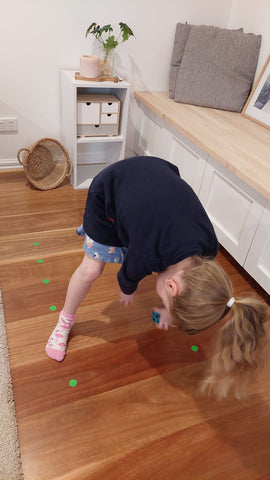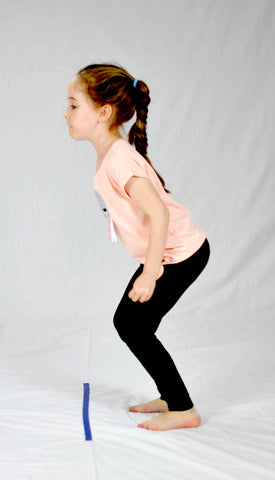My passion for improving children’s balance skills comes from watching my son Hugh for years try to avoid playing with his friends at a play centre, and avoid running around with his friends at a playground, because we felt nervous about losing his balance on climbing frames, wobbly bridges, and stepping stones.
If I can help one child become a more confident mover while at a playground with their friends or family, then my journey that I have had with Hugh will be worth every minute, every tear, and every ounce of frustration that both Hugh and I have experienced over the past 10 years.
What is balance, and why do children need to learn how to balance?
The ability to balance means the ability to keep the body upright without falling over or losing balance. There are two types of balance. Static balance which we need when we stand in line at the supermarket, or when holding a yoga pose with standing on one foot, and dynamic balance.
We need dynamic balance when we are walking up and down stairs, walking across wobbly bridges or river beds, moving from left to right to chase a football, etc. For all of us to be able to balance we need 3 balance systems to work together smoothly.
These 3 balance systems are our visual system (eyes), vestibular system (inner ear), and somatosensory system (feet).
Our visual system is most responsible for our ability to balance. Our eyes look at the trees, play equipment, and buildings in our environment and tell our body whether we are upright, laying down, moving, or standing still.
When we’re trying to stand on one foot without wobbling, we often find it easier to balance by staring at an object or a spot on the wall that isn’t moving. This is because our eyes have a key part to play in helping our body maintain an upright body position.
For some children, their visual system may require extra support from the other two balance systems, including the vestibular system that is located in the inner ear and the somatosensory system which receives information from the feet. For children who wear glasses or have difficulty with hand-eye coordination, they may need additional practice developing the vestibular system and the somatosensory system, as their eyes may not be taking responsibility of their balance.
This is ok. There are ways to teach children how to balance through their inner ear, vision, and feet. Check out www.playmoveimprove.com.au for an easy to follow, free, balance movement routine.
The vestibular system is located in the inner ear and when we move our head up, down, left, or right, the vestibular system tells our brain that our head is moving, and the brain then adjusts the position of our ankles, knees, hips, and spine, so that we don’t fall over.
The vestibular system is where my son Hugh experienced most of his motor development and balance challenges. To support Hugh with his development, we still to this day do a lot of hand-eye coordination and head movement activities, to help Hugh with his coordination and balance.
You can feel the vestibular system working in action, when you stand up in a safe area (not the bathroom, kitchen, or on slippery flooring), and stand on one foot. While you’re standing on one foot, as you slowly move your head up and down, and feel how much more your ankles and hips wobble. The vestibular system is telling your brain that your head is moving up and down, and your brain is telling your ankles and hips to move accordingly so that you don’t topple over and lose your balance.
Pretty amazing hey!
The third system of our balance is the somatosensory system. I sometimes refer to this system as a proprioception function because when the feet feel a change in pressure in the ankles, or change in surface or texture while you’re walking and balancing, the brain then tells the muscles of your body to adjust their position to stop you from falling over.
For example, as your feet walk across soft sand, your ankle and hip muscles change the way that they move so that you maintain an upright position. Similarly, when you walk in high heels or change from walking in thongs to barefeet, your muscles change the way that you move to avoid falling over.
To be able to balance smoothly, our body and brain needs all 3 of these systems to work together as a team.
For some children we develop the skill of balance quite easily, but for other children this motor skill requires extensive practice. Not all children develop their balance and motor skills smoothly.
We sometimes think that children develop the skills that they need for life just by moving through the ages from newborn to primary school age. Luckily for me, my two daughters have seemed to progress through their motor skills smoothly. However, for Hugh, he needed assistance and extra practice with each stage of his motor skill development, including his balance. Even yesterday I took Hugh to the creek and he needed my assistance and tips to ‘stand tall’ and ‘squeeze his belly muscles’ so that he could follow his sister across the creek without falling into the flowing water.
I talk to Hugh about the importance of safely challenging our balance every day. Even us adults can benefit from walking across a cushion obstacle course, or standing on one foot while throwing a scrunched up piece of paper back and forth. Our most recent game to play is tapping a soft wall back and forth with each other using our hands and straight legs (similar to a standing hamstring stretch). This action encourages our vestibular system to be responding to our body upside down, while our somatosensory system is at work as we require agility to move towards the moving ball, and our vision is getting an upside visual as well as visually tracking the moving ball.
As a parent of a child who tripped over and fell pretty much every day, I could have tried to wrap Hugh up in bubble wrap and allow Hugh to avoid the ‘risky’ playground. But what would that have done for Hugh’s balance? How would Hugh have improved his balance if he didn’t learn how to recover from a trip, or a near miss with his balance?
We need to develop a safe level of risky play for challenging children’s balance skills each day. Let’s all work together to change the way parents and our early childhood teams feel about balance, so we can reduce the risk of falls not only for this generation’s children, but this generation’s elderly in 70 years to come.
~ Robyn Papworth - Developmental Educator, Exercise Physiologist





